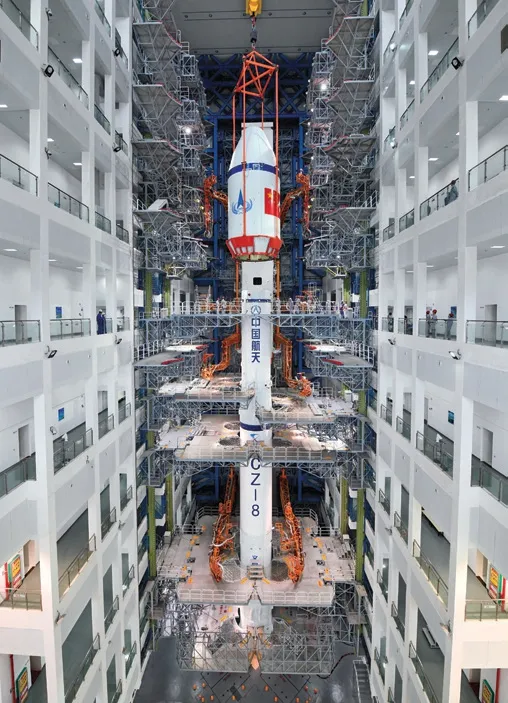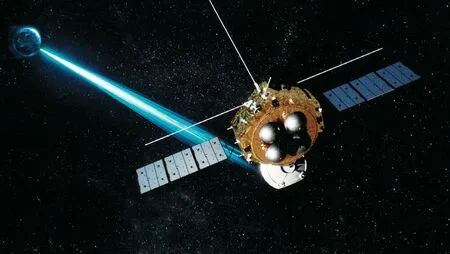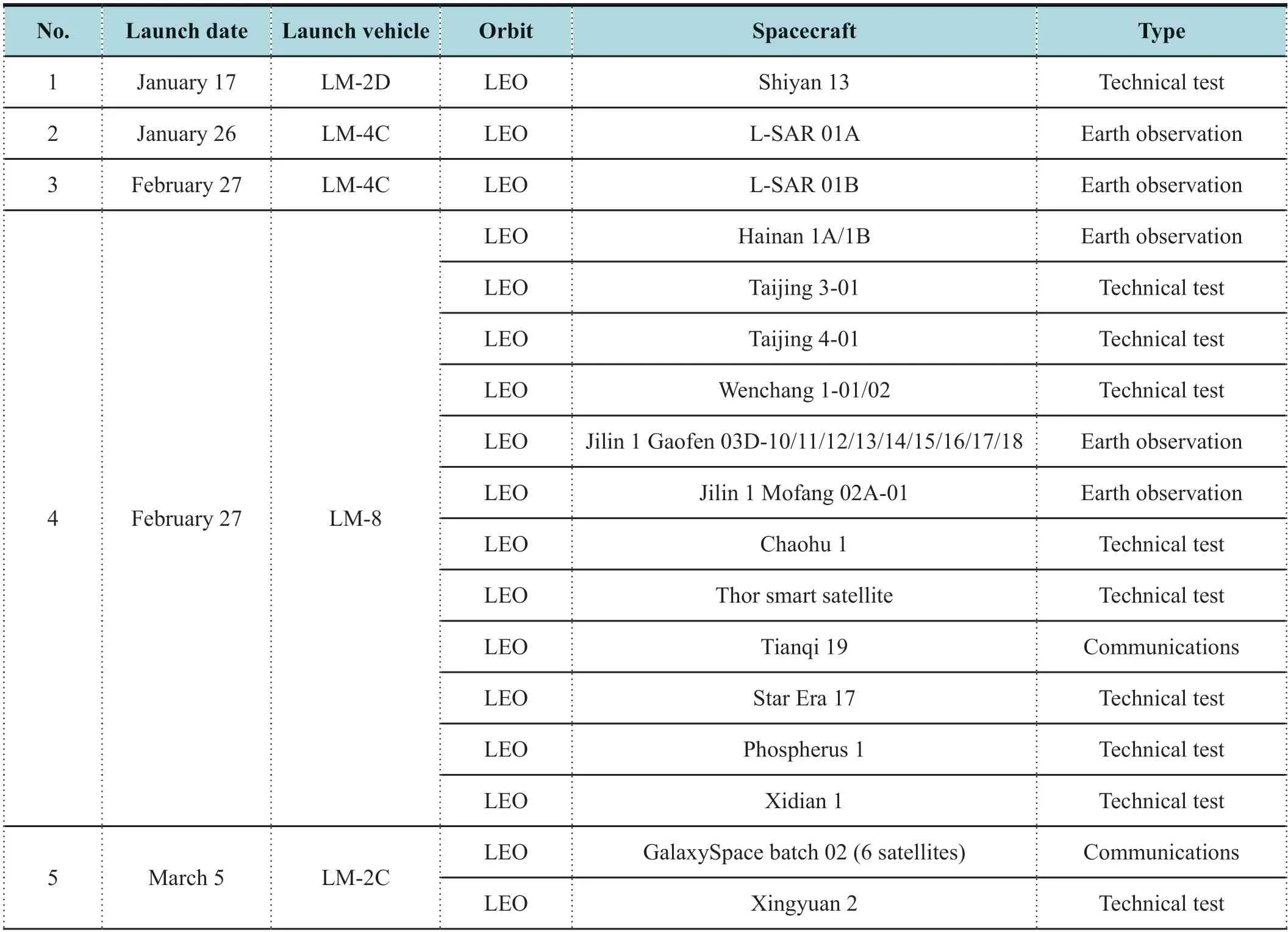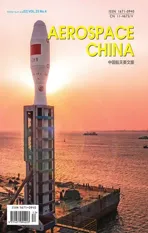CASC Released Blue Book of China Aerospace Science and Technology Activities in 2022
2022-07-15
China Aerospace Science and Technology Corporation(CASC) released the 2022 Blue Book of China Aerospace Science and Technology Activities on January 18,2023.According to the blue book,China will conduct nearly 70 launch missions in 2023,among which more than 60 space flights will be arranged by CASC,putting over 200 spacecrafts into space for a series of major space missions.The 4th stage of the lunar exploration project and the planetary exploration project will be pushed forward with the starting of the development of Chang’e 7 and Tianwen 2 probes;several scientific and operational satellites for national civil space infrastructure will be launched;the LM-6C launch vehicle will achieve its maiden flight to further perfect the spectrum of the Long March series carrier rockets.
MORE SPACE MISSION HIGHLIGHTS IN 2023
The blue book identifies that the accumulated launches conducted by the LM series launch vehicle will reach to a record 500.Three backup satellites for the BeiDou 3 global navigation satellite system are scheduled to be launched to further strengthen the reliability of the system.The FY-3 06/07 satellites,Huanjing 2-06 satellite,high-orbit 20 m-SAR satellite,new-generation Haiyang water color observation satellite,ChinaSat-26,ChinaSat-6E and Satellite A for the Macao Scientific Satellite 1 mission will be placed into orbits to better serve social life as well as the growth and construction of the national economy.CASC will speed up the construction of its new-generation commercial remote sensing satellite system by sending 7 Siwei SuperView series satellites into space,providing high-efficiency and high-performance spatio-temporal information services for customers in traditional and emerging markets.

LM-8 carrier rocket is preparing for launch
CASC will maintain high-intensity R&D and application tasks by promoting the projects of the 4th phase of the lunar exploration and the planetary exploration,concentrating its effort on research and development on several programs,including the Chang’e 7 lunar probe,Tianwen 2,GEO microwave exploration satellite and fulfilling the implementation of several commercial space and whole-satellite export contracts.
Oriented to the demands of national major strategies,economic and social development,CASC will continue to improve the integration of satellite applications into emerging areas,and support the economic development of key regions.The application of the BeiDou system will be extended to value added services from system integration with further efforts in the civil aviation industry,meanwhile expanding into other critical industries including energy and emergency.Making advantages with ground-space integration and comprehensive applications of satellite communications,navigation and remote sensing,CASC will focus on the opportunities of industrial and local governmental intelligence upgrades,building an integrated production system and supplying solutions for operational integrated applications.
CASC will carry out multiple commercial launch missions for the deployment of PIESAT-1,Jilin 1,GeeSAT and CentiSpace constellations,while publishing officially the information on available launch capacity,providing launch and piggyback opportunities for commercial customers as well as a quick,stable and reliable “one-stop” launching service to various kinds of customers to promote the healthy development of China’s commercial space sector.
DIFFICULTIES IN SPACE STATION TASK
MA Tao,an official from CASC announced that as the manned space station project enters the application and development phase,China’s Space Station has transferred to the normalized operation mode,China will complete launches of one cargo,two crewed and two return missions in 2023.
China’s T-shaped space station was completed on November 3,2022,and is orbiting normally in space as a complex with the Shenzhou 15 crewed spaceship and Tianzhou 5 cargo ship.The three-module space station will operate with the T-shape as the basic configuration for the long term,and extravehicular activities of astronauts and goods will be conducted aboard to support programs related to space science,materials and technical experiments.At the same time,maintenance and technical upgrade of the space station infrastructure will be arranged.Three “firsts” will be conducted in 2023,including the extravehicular payload support for a cascaded large and a small robotic arm,the payload installation by the smaller robotic arm and the extravehicular activities of astronauts and goods simultaneously.Tasks including in-orbit propellant refilling,electric propulsion testing and application and updates of several software systems will also be conducted in 2023.It is very difficult to implement this year’s in-orbit tasks for the space station and payload support,so it is a heavy task for ground support and development.

Artist’s concept of L-SAR 01 satellites networking
As for the crewed spaceship missions,the R&D for the spaceships remains at high intensity with several ships being developed in parallel.It has become normal to launch a spaceship every six months.According to the schedule,Shenzhou 16 and Shenzhou 17 crewed spaceships will be launched this year and a Tianzhou 6 cargo spacecraft will deliver supplies to the space station,including living necessities for astronauts on-board,test equipment and consumables for long-stays in space.
HEAVY LAUNCH VEHICLE PROJECT
China’s heavy launch vehicle development has always been a concern.An expert from the China Academy of Launch Vehicle Technology under CASC disclosed that the general concept of the seriation in configuration of the heavy launch vehicle has been clarified and the concept appraisals for systems such as TT&C at the launch site are under going.The conditions for project approval have been met and they will apply for project establishment.
The heavy launch vehicle can be used in many fields for a range of coverage,providing basic support for the implementation of large scale deep space explorations,such as building of a lunar scientific station,exploitation and utilization of lunar resources as well as construction of a research station on Mars and crewed Mars exploration.
China’s heavy rocket adopts three stages in serial as the basic configuration,with the launch capacity for the Earth-moon transfer orbit of 50 tons for deep space exploration missions.The 11-meter high carrier rocket has a 10-meter class rocket body diameter and has a lift-off weight of 4000 tons,giving a liftoff thrust of 6000 tons.The first stage is reusable.Based on the basic configuration,a two-stage serial configuration without the third stage is capable of carrying out near Earth orbit missions with a LEO launch capacity of 150 tons.In the future,the critical technologies for reuse of the second stage after orbital reentry will reach a breakthrough to develop a heavy launch vehicle with reusable ability.
The critical technology research and concept appraisals for the heavy launch vehicle were approved in June 2016.12 topics have been completed with critical technical breakthroughs,and are scheduled for final acceptance this year.Relying on the updated results achieved,the engineering development of the heavy launch vehicle might be finished 10 years after the project approval on the condition of all guarantees are in place in a timely manner.

Artist’s concept of Yaogan 34-04 satellite
CHINA’S SPACE ACHIEVEMENTS IN 2022
In the field of launch activities,2022 witnessed China’s high-density launch missions and high success rate,the rapid increase of the number of spacecraft developed and launched,the great improvement of R&D capabilities and the development leap in the ability to access and utilize space.
In the area of scientific innovations,breakthroughs have been achieved in launch vehicles,manned spaceflights,lunar and deep space explorations,application satellites,science and technology tests with several major scientific results.
In the sector of application services,the BeiDou navigation system provides global service,ChinaSat and APstar satellites supply consecutive services,space infrastructure has the ability of all-weather and all-time Earth observation,multiple services provided by all kinds of application satellites have played a significant role in all areas of economic and social development.
As for international cooperation,many kinds of bilateral and multilateral cooperations have been conducted which actively promote international exchanges,industrial development and technological applications.
In commercial space sector,an industrial system and market system have been formed initially and are entering a new development phase which is market oriented and driven by applications from the stage dominated with basic manufacturing and product development.The commercial space sector is speeding up its deployment to become an important strength in building China into a space power.
In 2022,China conducted 64 launch missions,developed and launched 188 spacecrafts with the total mass of 197.21 tons,ranking the second in the world,and all data has reached a record high in history.CASC finished 54 launches with a 100%success rate,among which the LM series launch vehicle carried out 53 launches,and Smart Dragon 3 once.The LM series carrier rocket has achieved 128 consecutive successes.(CASC)

Table 1 China’s space launch activities in 2022
杂志排行
Aerospace China的其它文章
- Transportation of the Kinetica-1 Carrier Rocket
- Smart Dragon 3 Launch Vehicle System
- Development Status and Main Application Progress of the Kinetica-1 Solid Launch Vehicle
- Development Status and Prospects of Solid Rocket Motor Technology for Large Launch Vehicles
- Research on Key Technologies for Reusable Liquid Rocket Engines
- Psychological Issues in Simulated Space Missions: What We Learn From Chinese Crew
